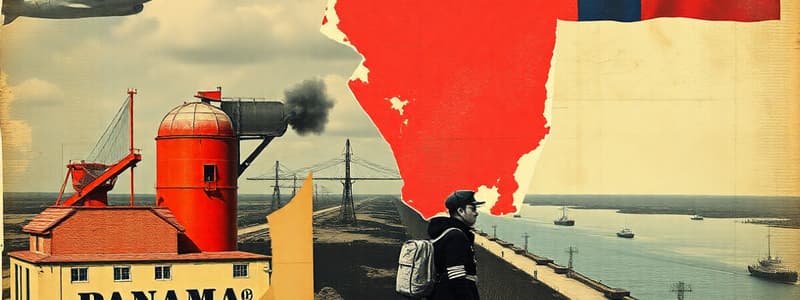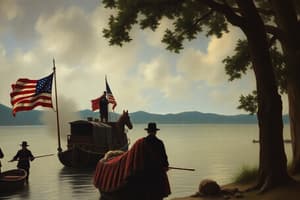Podcast
Questions and Answers
How did the acquisition of Alaska contribute to the United States' strategic interests in the late 19th century?
How did the acquisition of Alaska contribute to the United States' strategic interests in the late 19th century?
- It opened new trade routes with Asia, enhancing U.S. commercial opportunities.
- It eliminated the presence of a European power in North America near U.S. territories. (correct)
- It established a crucial military base to counter British naval power in the Pacific.
- It provided access to abundant gold reserves, boosting the U.S. economy.
What was the primary significance of the Spanish-American War for the United States?
What was the primary significance of the Spanish-American War for the United States?
- It facilitated the expansion of U.S. territorial holdings and global influence. (correct)
- It marked the beginning of a period of isolationism in American foreign policy.
- It resolved long-standing border disputes with Mexico and Canada.
- It led to significant reforms in domestic social and economic policies.
What broader goal did the construction of the Panama Canal aim to achieve for the United States?
What broader goal did the construction of the Panama Canal aim to achieve for the United States?
- To establish a major center for international diplomacy and peace negotiations.
- To demonstrate American engineering prowess and technological superiority.
- To facilitate faster and more efficient trade and military transport between the Atlantic and Pacific Oceans. (correct)
- To create a buffer zone protecting U.S. interests in Central America from European interference.
How did muckraking journalists contribute to the Progressive Era?
How did muckraking journalists contribute to the Progressive Era?
How did Theodore Roosevelt's 'Square Deal' aim to balance the interests of different groups in American society?
How did Theodore Roosevelt's 'Square Deal' aim to balance the interests of different groups in American society?
How did the introduction of direct primaries, initiatives, and referendums aim to reform the American political system during the Progressive Era?
How did the introduction of direct primaries, initiatives, and referendums aim to reform the American political system during the Progressive Era?
Why did the sinking of the Lusitania contribute to the United States' entry into World War I?
Why did the sinking of the Lusitania contribute to the United States' entry into World War I?
What was the primary goal of Woodrow Wilson's Fourteen Points?
What was the primary goal of Woodrow Wilson's Fourteen Points?
How did the Great Migration transform American society during and after World War I?
How did the Great Migration transform American society during and after World War I?
How did the rise of consumer culture in the 1920s affect American society?
How did the rise of consumer culture in the 1920s affect American society?
What was the primary focus of the Harlem Renaissance?
What was the primary focus of the Harlem Renaissance?
How did the Immigration Act of 1924 reflect nativist sentiments in the United States?
How did the Immigration Act of 1924 reflect nativist sentiments in the United States?
How did Prohibition contribute to the rise of organized crime in the 1920s?
How did Prohibition contribute to the rise of organized crime in the 1920s?
What did the Scopes Trial symbolize about American society in the 1920s?
What did the Scopes Trial symbolize about American society in the 1920s?
How did the stock market crash of 1929 impact the American economy?
How did the stock market crash of 1929 impact the American economy?
How did the US transition from a continental power to a global empire between 1865 and 1913?
How did the US transition from a continental power to a global empire between 1865 and 1913?
What was the lasting impact of the Progressive Era on the role of government in American society?
What was the lasting impact of the Progressive Era on the role of government in American society?
In what ways did World War I change the economic standing of the United States in the global arena?
In what ways did World War I change the economic standing of the United States in the global arena?
What were the key factors that contributed to the reactionary conservatism of the 1920s?
What were the key factors that contributed to the reactionary conservatism of the 1920s?
Which of the following ways did the Progressive Era fall short in addressing the needs and rights of all Americans?
Which of the following ways did the Progressive Era fall short in addressing the needs and rights of all Americans?
Flashcards
American Imperialism
American Imperialism
Expansion of a nation's authority by territorial acquisition or economic/political dominance.
Alaska Purchase of 1867
Alaska Purchase of 1867
Purchase of Alaska from Russia
Spanish-American War
Spanish-American War
Conflict between Spain and US in 1898
US Territories Acquired in 1898
US Territories Acquired in 1898
Signup and view all the flashcards
Admiral Alfred T. Mahan
Admiral Alfred T. Mahan
Signup and view all the flashcards
Progressive Era
Progressive Era
Signup and view all the flashcards
Muckraking Journalists
Muckraking Journalists
Signup and view all the flashcards
Social Gospel
Social Gospel
Signup and view all the flashcards
19th Amendment
19th Amendment
Signup and view all the flashcards
17th Amendment
17th Amendment
Signup and view all the flashcards
Square Deal
Square Deal
Signup and view all the flashcards
Woodrow Wilson's 'New Freedom'
Woodrow Wilson's 'New Freedom'
Signup and view all the flashcards
Zimmermann Telegram
Zimmermann Telegram
Signup and view all the flashcards
Great Migration
Great Migration
Signup and view all the flashcards
Fourteen Points
Fourteen Points
Signup and view all the flashcards
1920s
1920s
Signup and view all the flashcards
Harlem Renaissance
Harlem Renaissance
Signup and view all the flashcards
The Lost Generation
The Lost Generation
Signup and view all the flashcards
Immigration Act of 1924
Immigration Act of 1924
Signup and view all the flashcards
Scopes Trial of 1925
Scopes Trial of 1925
Signup and view all the flashcards
Study Notes
- The late 19th and early 20th centuries saw a rise in American imperialism, stemming from economic interests, new market desires, and a belief in American cultural superiority.
- In 1867, the U.S. bought Alaska from Russia, eliminating Russian imperialism in North America.
- Expansion continued in the Pacific with naval bases in Samoa and the annexation of Hawaii in 1898, despite Hawaiian protests.
- The Spanish-American War in 1898 led to the U.S. acquiring Puerto Rico, Guam, and the Philippines.
- Sparked by the USS Maine explosion and fueled by yellow journalism, the war emphasized the need for a strong navy.
- The Panama Canal, opening in 1914, was constructed due to advocacy from Admiral Alfred T. Mahan.
- "Dollar diplomacy" was employed in Latin America and East Asia to foster economic and political stability.
- The U.S. transitioned into a global empire, impacting both the nation and its acquired territories.
The Progressive Era
- The Progressive Era (1900–1920) addressed issues like industrialization, urbanization, and corruption through social and political reform.
- Progressives aimed to improve working conditions, regulate big business, and broaden democracy.
- Jane Addams, W.E.B. Du Bois, and Theodore Roosevelt were key figures in the movement.
- Muckraking journalists, such as Upton Sinclair, exposed corruption and social ills.
- Religious groups pushed for the social gospel, advocating for minimum wage laws and shorter workdays.
- The 19th Amendment in 1920 granted women the right to vote, marking a milestone for the women's suffrage movement.
- Direct primaries, initiatives, referendums, and the 17th Amendment (direct election of senators) were introduced.
- Theodore Roosevelt's "Square Deal" focused on controlling corporations, conserving resources, and protecting consumers, initiating nearly 25 anti-trust suits.
- The Meat Inspection Act and the Pure Food and Drug Act were significant legislation passed during his administration.
- Woodrow Wilson's "New Freedom" platform included the Federal Reserve Act and the Clayton Anti-Trust Act, continuing progressive reforms.
- Progressivism often excluded the poor and failed to address racial inequality.
America and the Great War
- The U.S. remained neutral in World War I until 1917, which began in 1914.
- The sinking of the Lusitania and the Zimmermann Telegram prompted the U.S. to join the war.
- The Wilson administration mobilized the nation with propaganda, the Selective Service Act, and war bonds.
- The Great Migration saw African Americans moving north for industrial jobs, resulting in significant social changes.
- The 19th Amendment granted women the right to vote.
- Wilson's Fourteen Points aimed to establish a peaceful post-war world, but the Treaty of Versailles and the League of Nations faced U.S. opposition.
- The war ended in 1918, but the U.S. faced post-war issues: the Red Scare and the Spanish Flu pandemic.
- The U.S. became a global creditor, but post-war isolationism grew, rejecting Wilson's internationalist vision.
A Clash of Cultures
- The 1920s brought cultural and social changes, including consumer culture, mass media, and modernism.
- Radios and automobiles transformed daily life amid an economic boom.
- The flapper challenged traditional gender roles.
- The Harlem Renaissance celebrated African American culture and art.
- The Scopes Trial highlighted the science vs. religion tension.
- Modernism in art and literature rejected traditional norms, with figures like T.S. Eliot and Gertrude Stein.
- The Lost Generation conveyed disillusionment with post-war society.
- Consumer culture and mass advertising promoted a more homogeneous American society.
- The Ku Klux Klan and restrictive immigration laws, like the Immigration Act of 1924, arose as a backlash.
- The 1920s saw progress and reaction as American society dealt with modernity's swift changes.
The Reactionary Twenties
- The 1920s involved reactionary conservatism through the Ku Klux Klan, immigration restrictions, and Prohibition.
- The Klan promoted "100 percent Americanism," targeting African Americans, Catholics, Jews, and immigrants.
- The Immigration Act of 1924 restricted immigration from southern and eastern Europe and banned almost all Asian immigration.
- Prohibition, via the 18th Amendment, aimed to reduce social ills but boosted organized crime and lawbreaking.
- The 1925 Scopes Trial pitted modern science against traditional religion.
- The stock market crash of 1929 ended the Roaring Twenties and started the Great Depression amid consumer culture and the stock market boom.
- The Depression caused widespread unemployment, poverty, and social unrest.
Studying That Suits You
Use AI to generate personalized quizzes and flashcards to suit your learning preferences.




